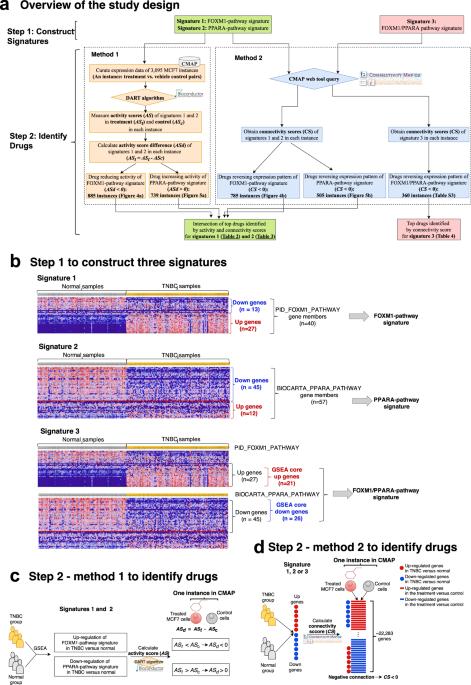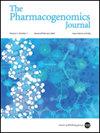生物信息学驱动发现调节乳腺癌 FOXM1 和 PPARA 通路活性的小分子化合物
IF 2.9
3区 医学
Q2 GENETICS & HEREDITY
引用次数: 2
摘要
我们之前的研究表明,在乳腺癌(BC)中,尤其是在三阴性乳腺癌(TNBC)亚型中,FOXM1通路上调,PPARA通路下调。靶向这两种通路可能为治疗乳腺癌提供潜在的治疗策略,尤其是 TNBC,因为在所有乳腺癌亚型中,TNBC 的有效疗法最少。在这项研究中,我们采用两种方法鉴定了可调节碱性细胞癌中 PPARA 和 FOXM1 通路的小分子化合物。在第一种方法中,我们首先从连接图(CMAP)数据库中收集数据,该数据库提供了经不同化合物处理的 MCF7 细胞以及配对对照组的基因表达谱。然后,我们从化合物诱导的基因表达谱中计算出每种处理方式下 FOXM1 和 PPARA 通路活性的变化,从而找出导致 FOXM1 通路活性降低或 PPARA 通路活性升高的化合物。第二种方法是利用 CMAP 数据库工具,找出能逆转 MCF7 细胞中这两种通路表达模式的化合物。我们对两种方法鉴定出的抑制 FOXM1 通路或激活 PPARA 通路的化合物进行了比较。我们发现了 19 种常见化合物,它们能降低 FOXM1 通路的活性评分并逆转 FOXM1 通路的表达模式;我们还发现了 13 种常见化合物,它们能提高 PPARA 通路的活性评分并逆转 PPARA 通路的表达模式。对这些化合物进行实验验证以进一步研究它们对TNBC的影响可能会很有意义。本文章由计算机程序翻译,如有差异,请以英文原文为准。

Bioinformatics driven discovery of small molecule compounds that modulate the FOXM1 and PPARA pathway activities in breast cancer
Our previous studies demonstrated that the FOXM1 pathway is upregulated and the PPARA pathway downregulated in breast cancer (BC), and especially in the triple negative breast cancer (TNBC) subtype. Targeting the two pathways may offer potential therapeutic strategies to treat BC, especially TNBC which has the fewest effective therapies available among all BC subtypes. In this study we identified small molecule compounds that could modulate the PPARA and FOXM1 pathways in BC using two methods. In the first method, data were initially curated from the Connectivity Map (CMAP) database, which provides the gene expression profiles of MCF7 cells treated with different compounds as well as paired controls. We then calculated the changes in the FOXM1 and PPARA pathway activities from the compound-induced gene expression profiles under each treatment to identify compounds that produced a decreased activity in the FOXM1 pathway or an increased activity in the PPARA pathway. In the second method, the CMAP database tool was used to identify compounds that could reverse the expression pattern of the two pathways in MCF7 cells. Compounds identified as repressing the FOXM1 pathway or activating the PPARA pathway by the two methods were compared. We identified 19 common compounds that could decrease the FOXM1 pathway activity scores and reverse the FOXM1 pathway expression pattern, and 13 common compounds that could increase the PPARA pathway activity scores and reverse the PPARA pathway expression pattern. It may be of interest to validate these compounds experimentally to further investigate their effects on TNBCs.
求助全文
通过发布文献求助,成功后即可免费获取论文全文。
去求助
来源期刊

Pharmacogenomics Journal
医学-药学
CiteScore
7.20
自引率
0.00%
发文量
35
审稿时长
6-12 weeks
期刊介绍:
The Pharmacogenomics Journal is a print and electronic journal, which is dedicated to the rapid publication of original research on pharmacogenomics and its clinical applications.
Key areas of coverage include:
Personalized medicine
Effects of genetic variability on drug toxicity and efficacy
Identification and functional characterization of polymorphisms relevant to drug action
Pharmacodynamic and pharmacokinetic variations and drug efficacy
Integration of new developments in the genome project and proteomics into clinical medicine, pharmacology, and therapeutics
Clinical applications of genomic science
Identification of novel genomic targets for drug development
Potential benefits of pharmacogenomics.
 求助内容:
求助内容: 应助结果提醒方式:
应助结果提醒方式:


